If you want the most perfectly moist, flavorful, and juicy Thanksgiving Turkey, my dry brine turkey recipe is what you’re looking for. All you need to do is rub the turkey down with salt, seasonings, and fresh herbs. Then, place the turkey in the fridge and let the dry brine work its magic for the next 48 to 72 hours.
That’s all you need the prep you need to do, and you’re on your way to enjoying the best turkey you’ll ever eat!
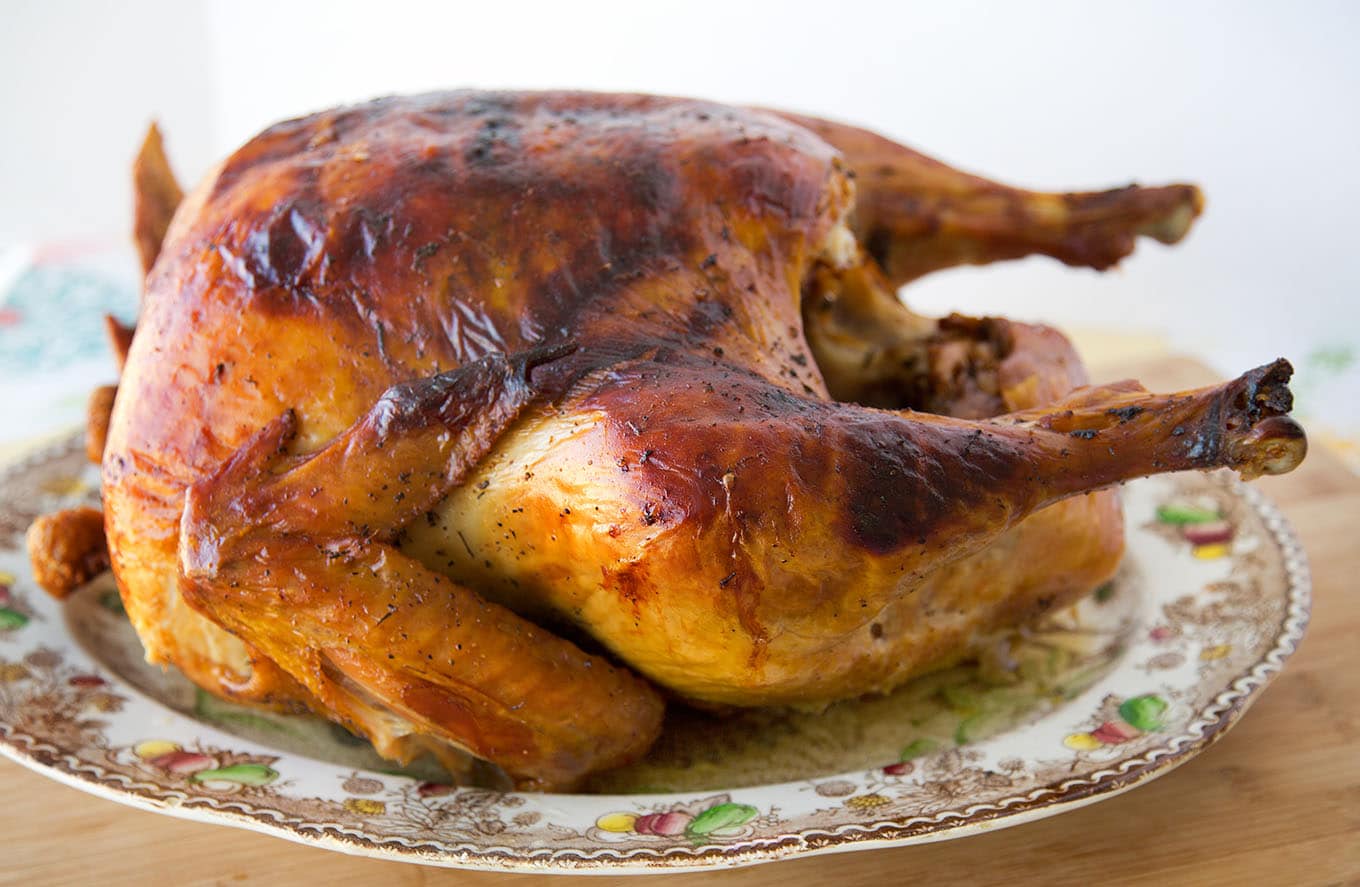
When it comes to cooking a turkey, what you do before it goes into your oven makes all the difference in the world.
Don’t be intimidated by the thought of cooking a turkey. Because I’m here to share my dry brining and roasting methods to make your holiday turkey the star of the holiday dinner
There are different thoughts on brining a turkey, with the choices being wet brine or dry brining. While both techniques will help you cook the most succulent turkey you’ve ever had, the smartest, easiest way to achieve the best results every time is with a dry brine.
It doesn’t matter if this is your first Thanksgiving dinner, my dry-brine method will make you look like a seasoned veteran of Thanksgiving and turn out an impeccably juicy, flavorful bird.
If you’re looking for a non-traditional dessert for the holidays, my Tiramisu will be the perfect ending to your holiday meal.
Ingredients
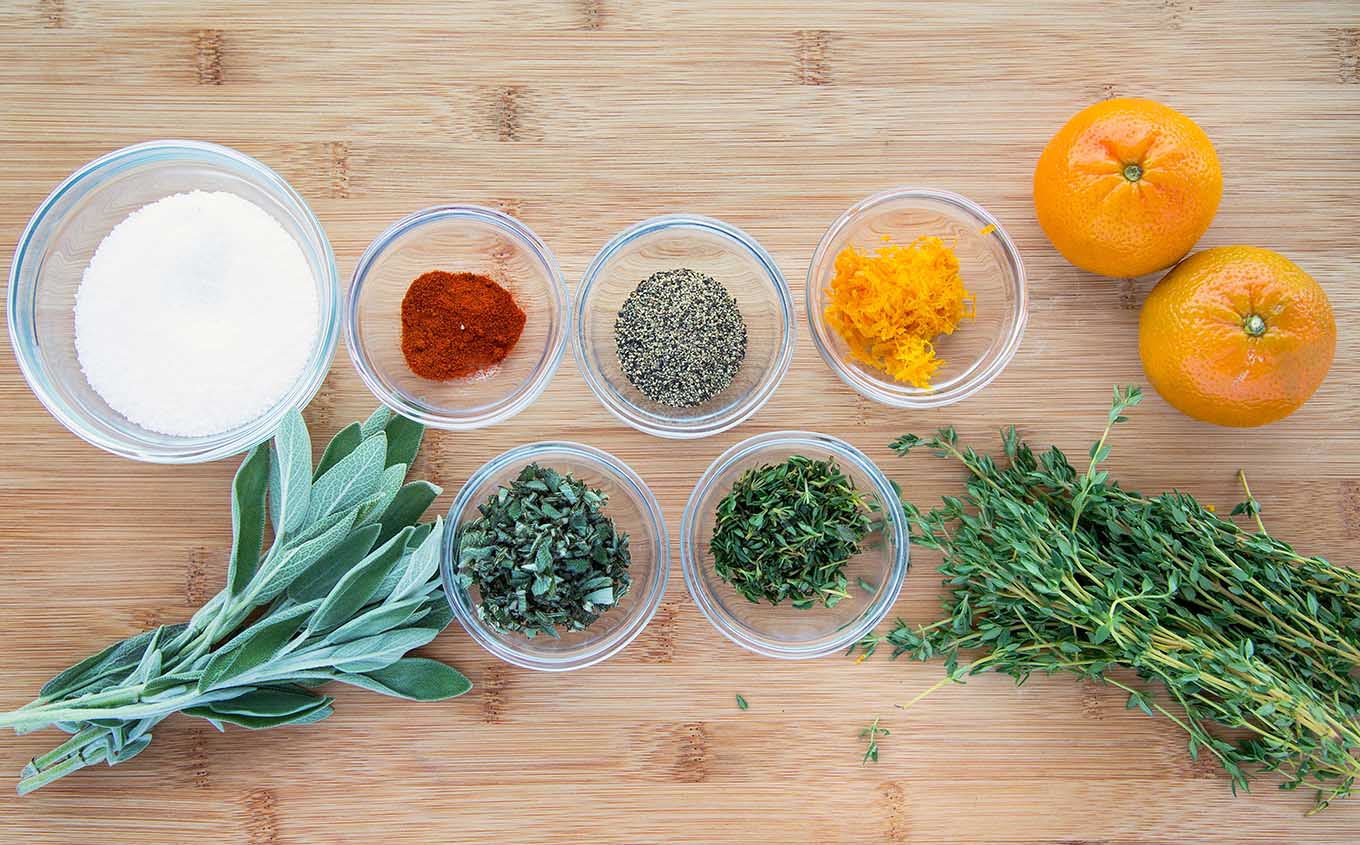
Let’s start by gathering the ingredients we need to dry brine our turkey. In Chef Speak, this is called the Mise en Place, which translates into Everything in its Place.
Not only does setting your ingredients up ahead of time speed the cooking process, but it also helps ensure you have everything you need to make the dish.
- Kosher Salt
- Black Pepper
- Smoked paprika
- Citrus zest
- Fresh thyme
- Fresh Sage
Do I have to use specific herbs and spices to dry brine a turkey?
That’s a tricky question because if you want a traditional Thanksgiving turkey, the answer is yes.
But If you like specific flavorings and aren’t into traditional Thanksgiving flavors, then by all means, have fun substituting spices that you like.
Recipes should be used as guidelines, and in all honesty, the salt is the only ingredient you really need for dry brining; the rest are added for flavor.
Why Should I dry-brine my turkey?
When you’re dealing with a large piece of meat like a whole turkey, it’s easy to overcook it into a dry, flavorless disaster. Dry Brining gives the dry brine mixture time to penetrate into the meat.
Dry brining (dry rub) is a way to inject both flavor and moisture into a turkey, giving you a flavorful, moist, roasted turkey.
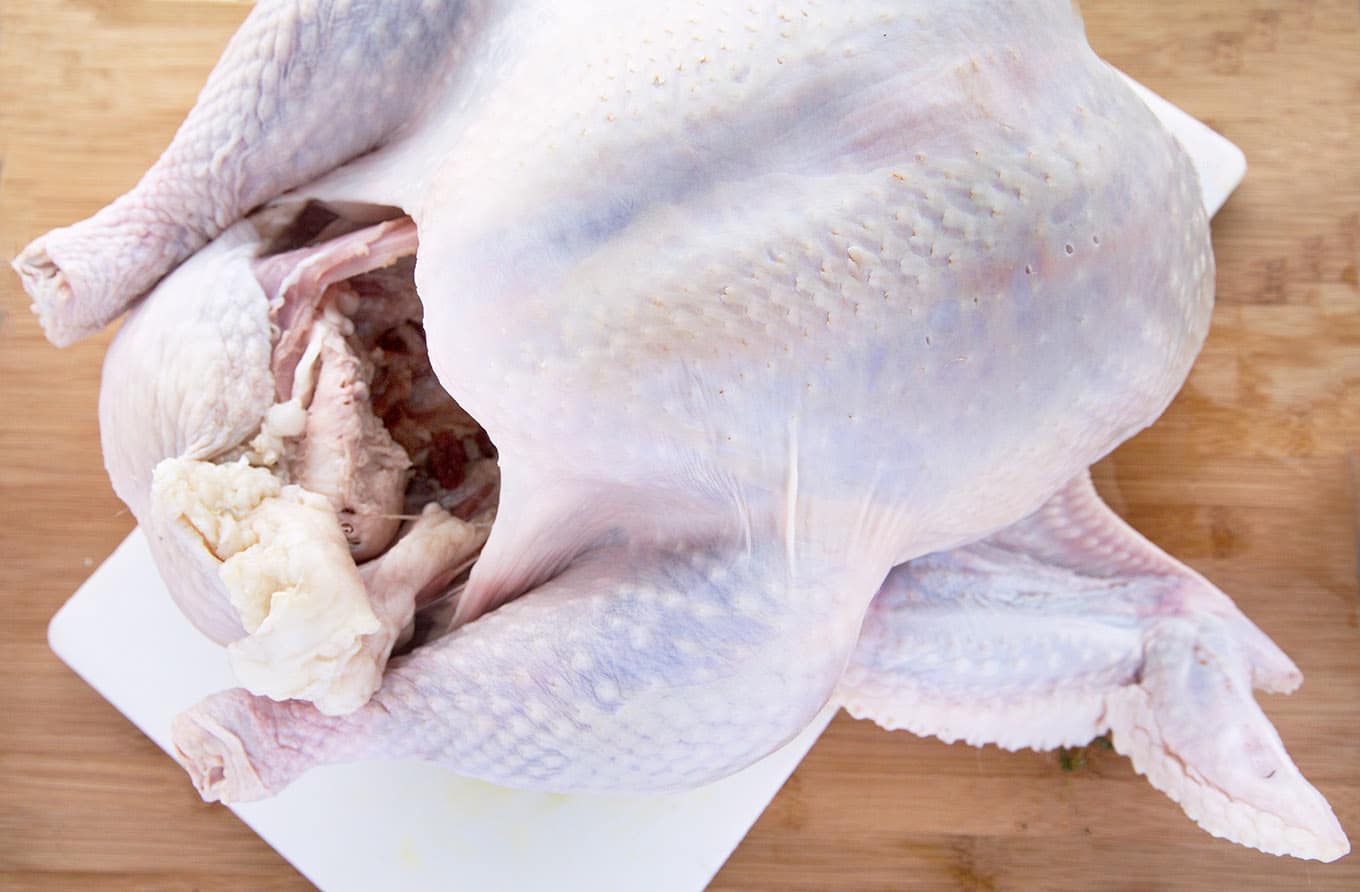
Rule #1 of Dry Brining
The larger the piece of meat, the more time is needed for the brine to be effective.
A dry brine, also called pre-salting, involves rubbing the salt, seasonings, and/or sugar directly onto the meat and skin and then letting the meat rest in the refrigerator for a period of time before cooking. During the process of dry brining, the salt draws out the juices through osmosis.
As the salt dissolves into the juices, it begins turning into a natural brine without any added liquid. This Natural brine is then reabsorbed into the meat and starts breaking down the tough muscle proteins. That is why this process needs up to 3 days to complete.
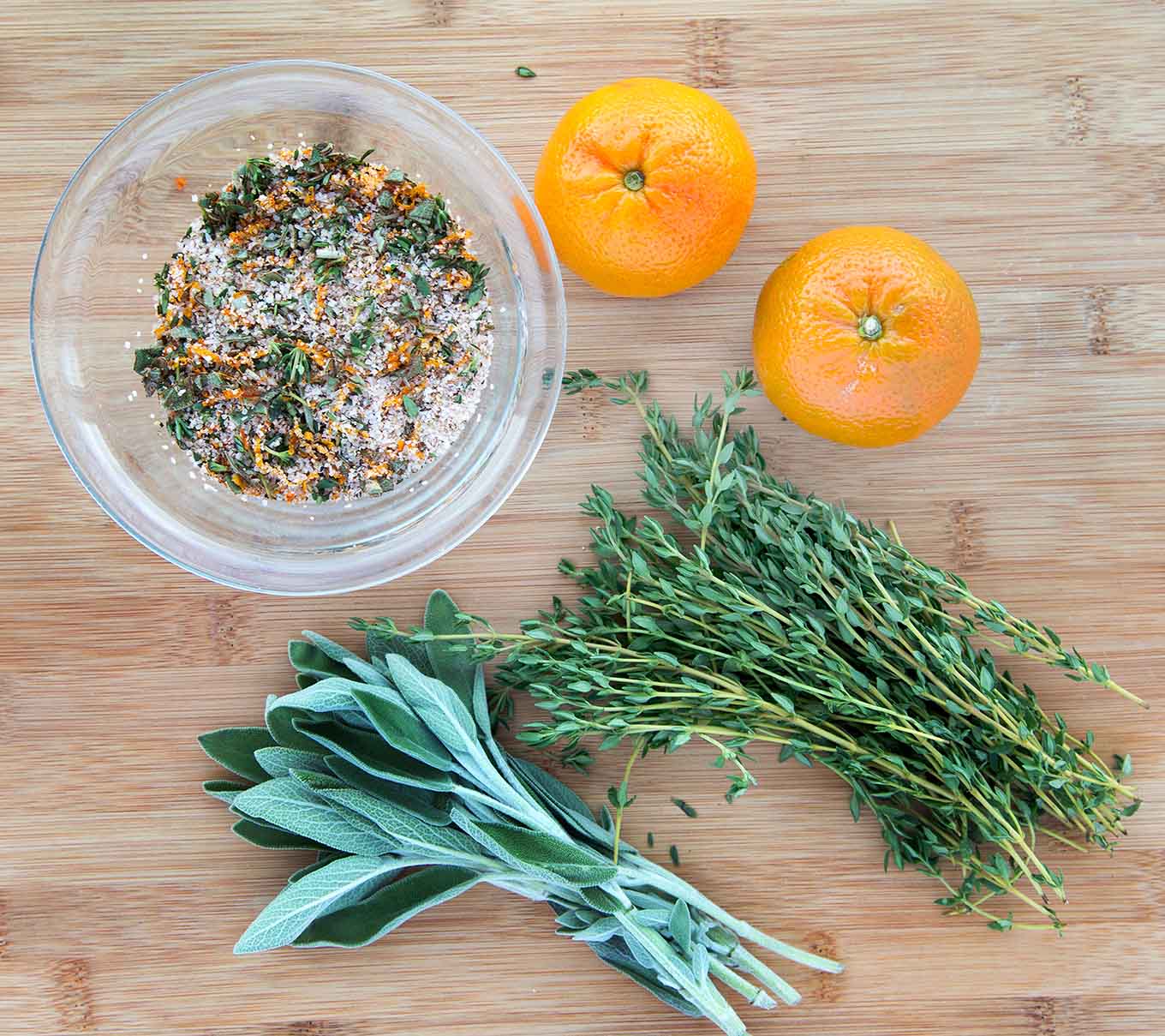
How to thaw a frozen turkey
The best way to thaw your turkey in the refrigerator in its original packaging. General defrosting times are 24 hours for every 4 pounds of Turkey.
If you have no choice and must thaw your turkey quickly, fill the kitchen sink with cold water and put the turkey in it, breast side down.
Make sure to completely submerge the turkey in water (in its original packaging) for the quick thaw method. Make sure to change the water every 30 minutes. This defrosting method will take 30 to 40 minutes per pound of turkey.
*When finished thawing the turkey, make sure to clean and disinfect the sink, spigots, and all surrounding surfaces.
*Don’t leave the turkey out to thaw on the countertop.
Chef Tips
- Don’t buy a preseasoned or kosher turkey (pre-salted) or self-basting turkeys. I always look for free-roaming or a heritage bird. But most importantly, no added salt.
- Make sure your turkey is thawed if you buy a frozen turkey. *Buy your turkey early enough so that it’s thawed and ready to brine on the Monday before Thanksgiving.
- It doesn’t have to be a whole turkey; you can dry brine a turkey breast.
- Getting under the skin of the turkey and applying the brine directly to the meat will make a tastier, moister turkey. If you’re only going to brine the skin, try and brine it for the full 72 hours.
- Don’t rush dry brining. To enjoy the best turkey you’ll ever have, you need to give it enough time to be effective. 2 days is the minimum, and can go as long as four days if you’re working with a 20-pound plus bird. *Any length of time you can brine the turkey is better than not brining the bird.
- You can use any herbs that you like, but the salt really does matter. Use Morton’s Kosher Salt for the best results. Diamond Kosher salt is a larger grain; if you use Diamond, increase the amount of salt by half. Don’t use table salt, it’s too fine and will make the turkey too salty.
- If you don’t have Kosher Salt, you can use Coarse Sea Salt or Coarse Himalayan Pink Salt because of the size of the coarse grains.
*The standard is one tablespoon of salt for every 5 pounds of turkey, but I like to go a little below that at one tablespoon of salt for every 6 lbs. So if you’re turkey is smaller, adjust the amount of salt and herbs.
Does it Matter Where I Apply the Mixture?
It does make a difference where you apply the dry brine. Separating the skin from the meat so that some of the dry brine can be rubbed directly on top of the meat (below the skin) will give you the best results.
If you apply the brine directly on the skin, it will need more time to penetrate the skin and get to the meat. The breast will also get more of the dry brine than the rest of the turkey. The turkey breast has the largest amount of meat on a conventional turkey.
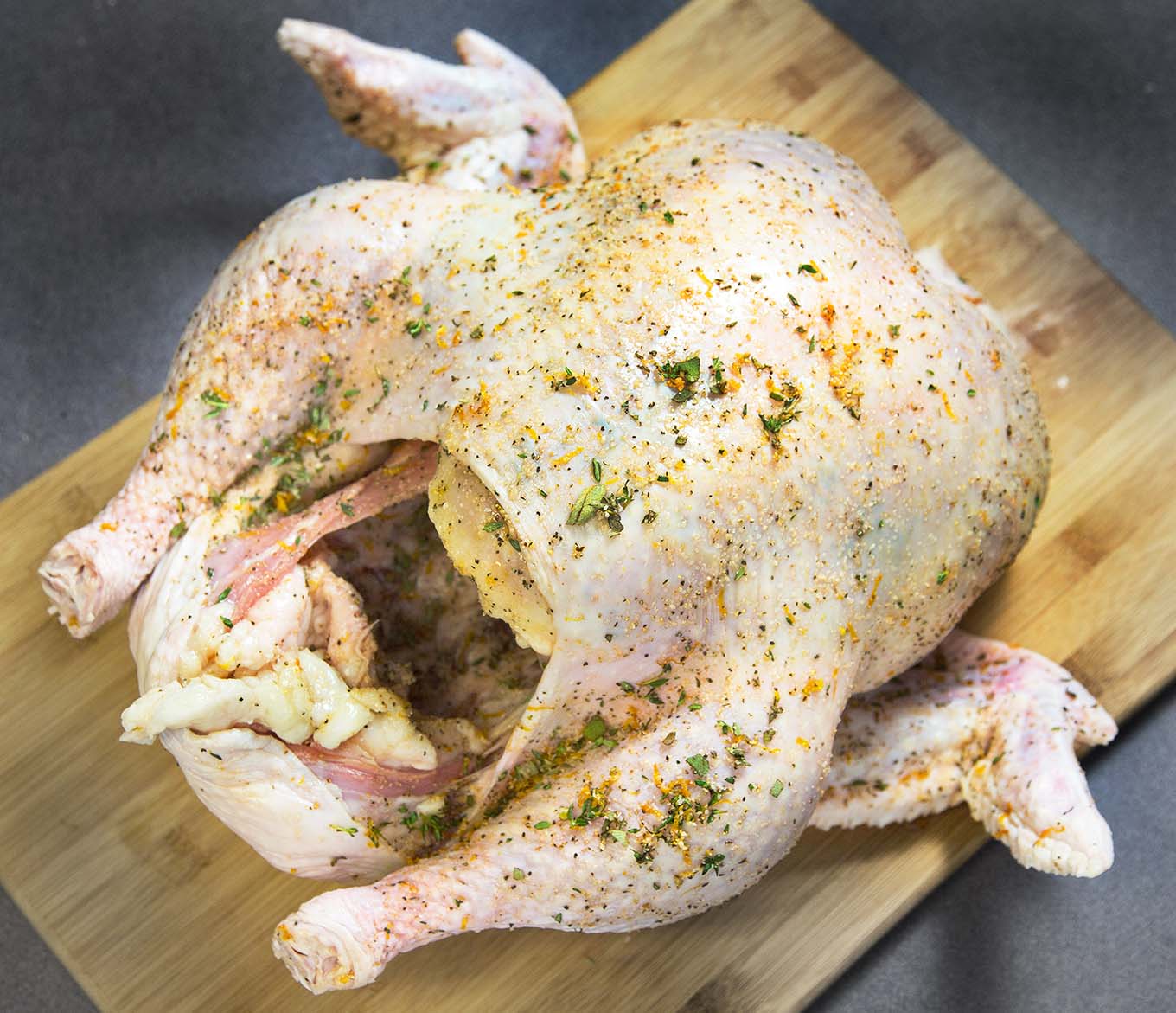
- After applying the dry brine, place the turkey breast side up in a roasting pan. Cover the turkey securely using plastic wrap. Or place it into a small plastic bag and seal it, removing as much of the air as possible. Refrigerate for 48 – 60 hours.
- Remove the plastic wrap and keep it refrigerated uncovered for the last 12 hours of brining. This will help crisp the turkey skin.
Can I use Dry Herbs?
Yes, you can, although I prefer fresh herbs. You can find them at most grocery stores in convenient little plastic containers. If fresh herbs are not available, by all means, use dry herbs. You can also add any other herbs or aromatics that you like.
Should I cook a Heritage Turkey Differently?
A heritage turkey is more elongated with drumsticks that are a good 1 to 2 inches longer than a modern bird, extending well beyond the tip of the breast.
Because of its more elongated shape, a heritage turkey cooks a little more quickly than a conventional turkey, so the biggest danger is overcooking. To make sure your Heritage Turkey is not overcooked, follow my recipe and change the cooking times.
Roast an unstuffed turkey at 425° for 20 minutes, then turn down the temperature to 325°F until the internal temperature of the thigh meat reaches 155°F.
Cooking 15-20 minutes per pound for the total cooking time. That being said, I would start checking the internal temperature 2 hours after the second phase of the process using an Insta-read thermometer in the thigh.
Also, make sure to allow 1-½ lb. per person compared to about one lb. for a conventional turkey. As an example, expect a 12-lb. heritage turkey to feed about eight people. Also, keep in mind that you’ll have as much dark meat as light meat. A conventional turkey will have more white meat.
Chef Tips for Roasting
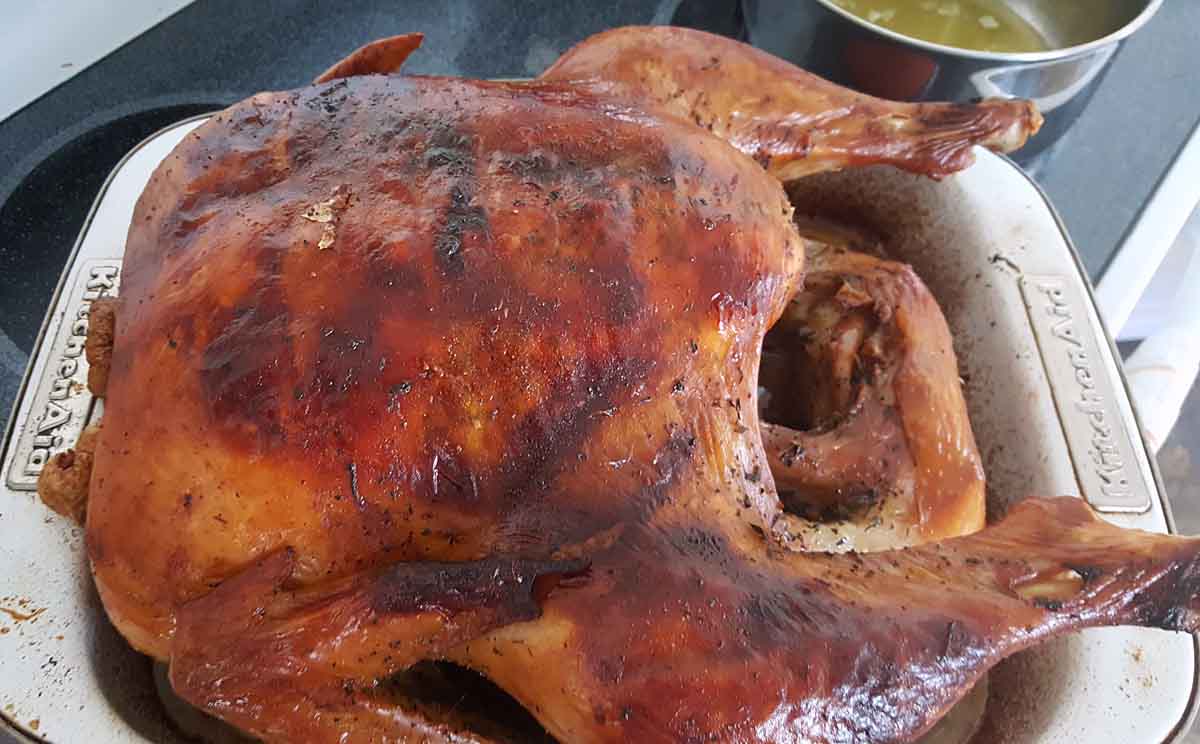
- Set your oven rack in the bottom third of the oven.
- Let the turkey sit out of refrigeration for about 30 minutes so it can come to room temperature before roasting.
- Allow the turkey to sit at room temperature for one hour before roasting. **Do Not Rinse The Brine Off Turkey
- Start off roasting the turkey at 425°F, and roast upside down for the first 45 minutes. At the end of that time, very carefully turn the turkey over with the breast side up to continue cooking.
- You’ll find that some ovens have cold spots. This is why it’s a good idea to rotate the turkey halfway through and baste for even cooking and browning. Keep some turkey or chicken stock handy in case your turkey doesn’t produce enough juice during the roasting process, and use that for basting if necessary.
- Always use an instant-read thermometer to ensure that your turkey has been cooked properly. Insert the thermometer into the thickest part of a thigh without touching the bone registers. Your turkey will be done when the thermometer reaches 165°F. It will continue to cook once you remove it from the oven, increasing by another 10 degrees.
- Let the turkey rest for 20-30 minutes before carving.
I absolutely love my Meater Plus | Smart Meat Thermometer. It takes all the guesswork out of cooking meats in the oven, on the grill, or in a smoker.
Do I have to start the turkey upside down?
No, you don’t. Safety should always come first and if you don’t think you can flip the turkey safely, skip that step. Still use the instruction for roasting starting at 425 degrees, then lowering to 325 degrees.
**If you do flip the turkey, take the pan out of the oven first. Don’t attempt this while the pan is in the oven.
You might also find heat-resistant gloves a good option. They’ll come in handy throughout the year.
Can I still Dry-Brine a Self-Basting or Kosher Turkey?
No, you can’t. That will make the turkey too salty! What you can do, is leave the salt out of the dry-brine ingredients and use the remainder of the seasonings as a dry rub. Feel free to add in your favorite spices.
Apply the dry rub for 24-36 hours and follow the roasting instructions.
My Turkey has been injected with a saline solution can I still use a dry brine?
While it’s not a good idea to add more salt to an injected turkey, you can still use the dry brine method. If your turkey is in the 15-pound range cut the Kosher Salt down to 1 Tablespoon. If your turkey is under 15 pounds reduce the salt accordingly. You can use the rest of the ingredients as stated in the recipe.
Why shouldn’t I stuff my turkey?
I know that the stuffing from inside the turkey is the best you’ll ever have. But it’s not a practice I recommend for two very important reasons.
The stuffing sucks a lot of the moisture (and flavor) out of the turkey. That’s why a stuffed turkey is often dry and overcooked. And the really bad news is, it puts us at risk for foodborne illness.
The longer it takes the turkey to reach an internal temperature of 165 degrees gives bacteria more time to multiply. And that means that uncle Sal (salmonella) might be paying you and your guests an unexpected holiday visit, which will definitely put a damper on the festivities.
**Stuffed turkeys also take longer to cook.
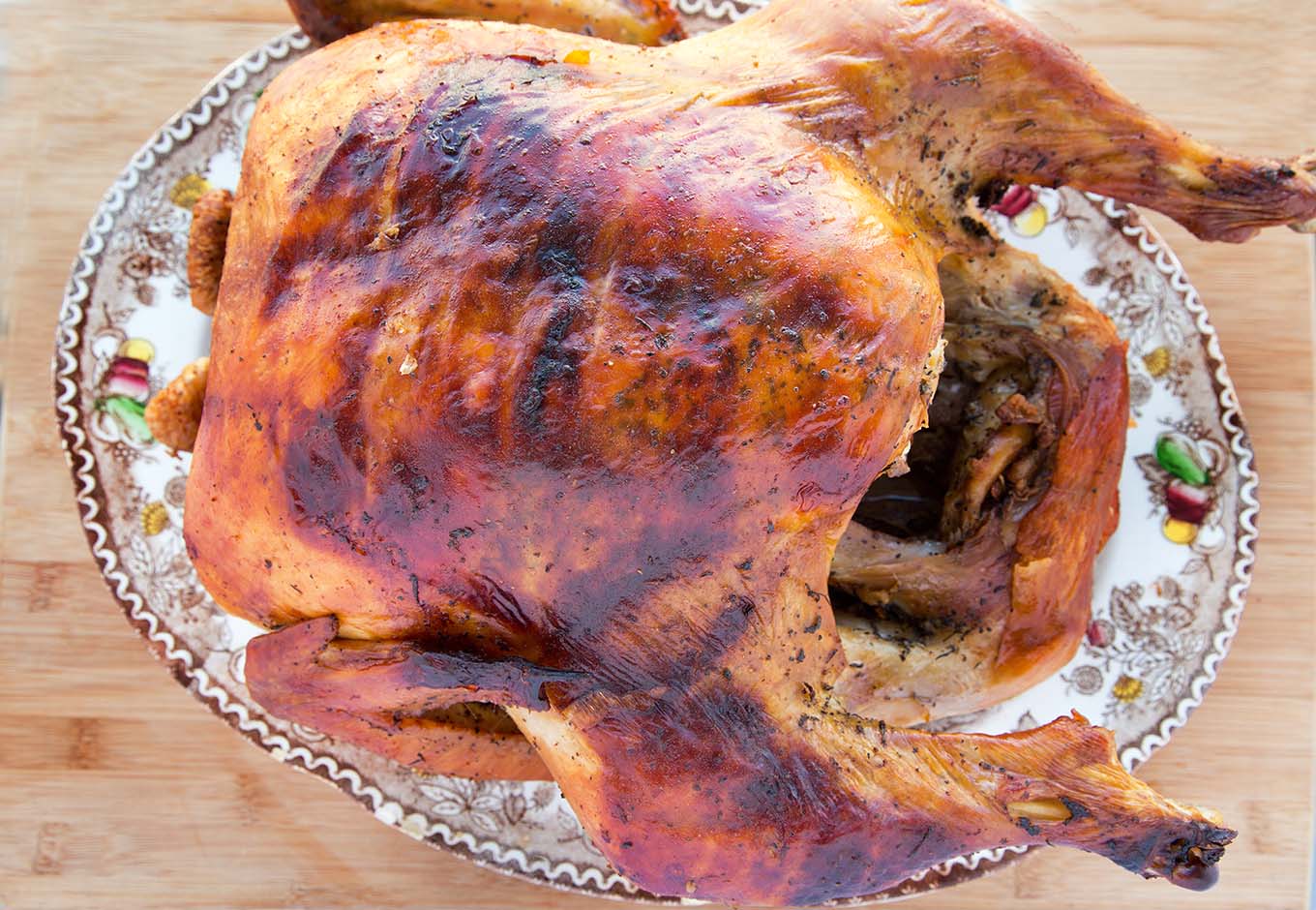
If you have leftover turkey, try my Old Fashioned Turkey Croquettes.
If you’re looking for a new Chef Knife, check out Misen. I’ve been using their kitchen knives for years!
Recipe FAQs
Dry-brining, also referred to as salting, is the process of rubbing the meat down with salt. The natural moisture content of the meat creates a concentrated brine that is naturally absorbed back into the meat before cooking.
A whole turkey needs two to three days of brining time. The dry-brining can be done days before Thanksgiving, giving you extra time on Turkey Day.
For the last 24 hours of the dry brine, leave the turkey uncovered in the refrigerator. This will dry out the skin, which in turn gives you incredibly crispy, golden-brown skin on the finished turkey.

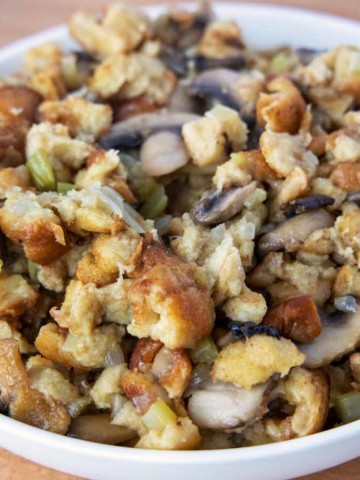
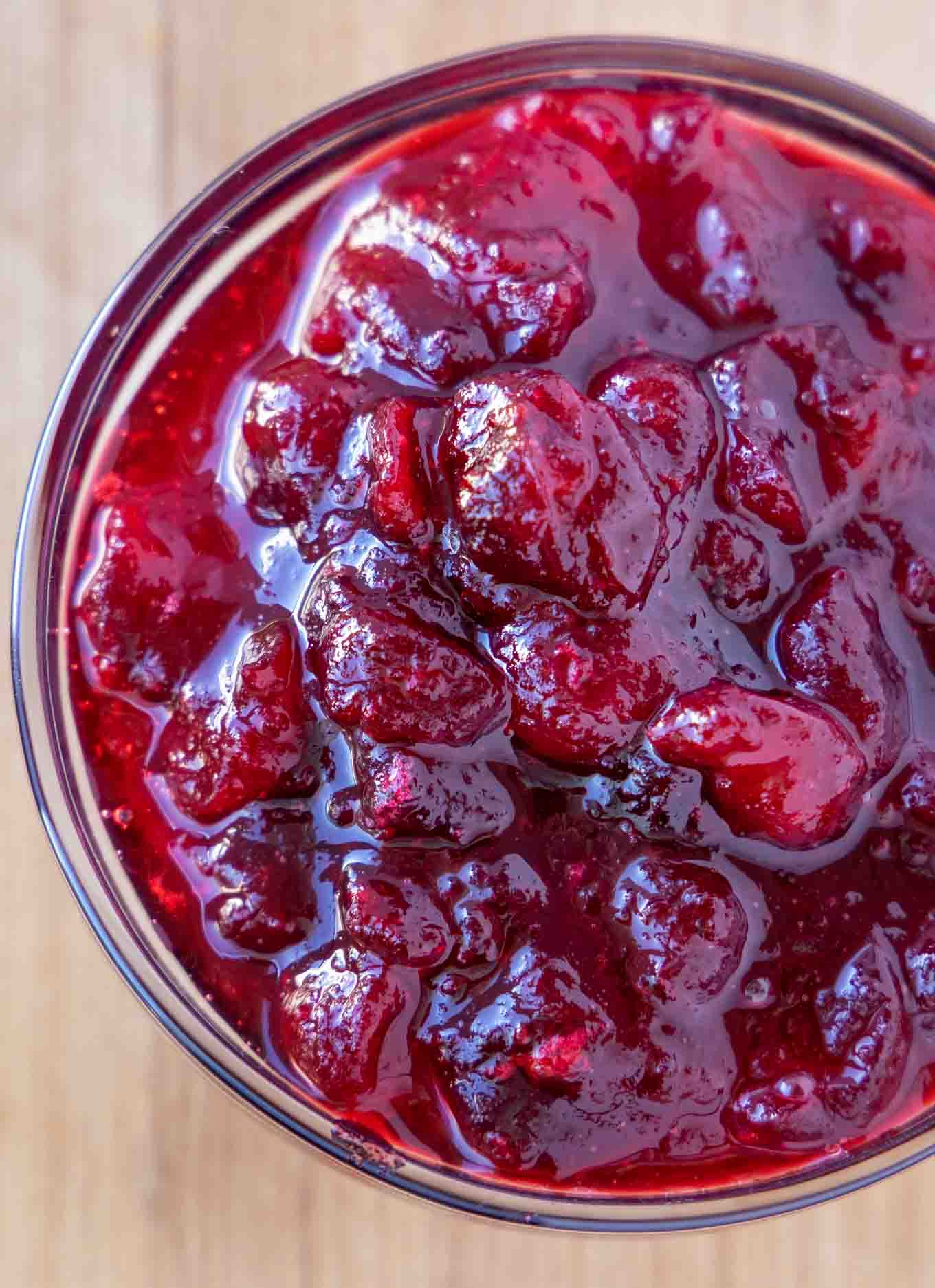
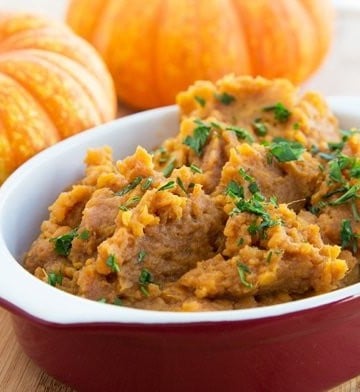
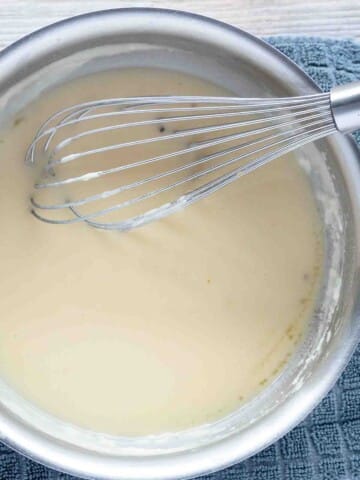
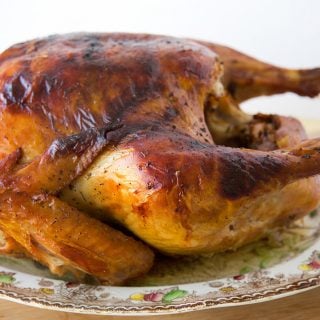
grace v. says
Chef, Thank you for this Most Excellent recipe. My turkey was out of this WORLD!!!!! Moist, Flavorful, fall off the bone DELICIOUS!!! I will never go back to the old standard, and it was easy to prep, your recipe ROCKS!!!!
Chef Dennis Littley says
You’re very welcome and I’m happy to hear you enjoyed your turkey.
Susan says
What do you recommend to put in the cavity of the turkey?
Chef Dennis Littley says
vegetables, herbs and other aromatics. I generally use onion, celery, carrot pieces. Sprig of thyme, rosemary or other herbs. Cut up orange or tangerine with skin.
Lin says
Chef Dennis, sorry if it’s a rather obvious question. But can I use this method for other poultry or game? Will it be good for duck or chicken? Thank you!
Chef Dennis Littley says
You certainly can use this dry brine for other poultry. This recipe is for a 12-14 pound turkey, so cut down the total amount of seasoning depending upon the weight of the poultry used.
Gisele says
My Turkey will just be defrosted the day before Thanksgiving. I read somewhere that if you coat it with the salt that close to roasting the salt will not have enough time to absorb and it will taste salty. Is this true?
Chef Dennis Littley says
if you apply the brine in my recipe, it will add flavor and you will get some benefit from the brine with 24 hours. 48 hours -72 hours is best
James N. says
Hey Chef Dennis, always a pleasure to see you back annually for turkey questions.
I have used your dry brine method for the last five years, exactly and sometimes with tweaks, and they’ve been the best five turkeys out of 20 years.
I’m curious… Why no rosemary in your brine? The holy trinity of herbs always seem to go together with poultry.
Chef Dennis Littley says
hi James
I’m happy to hear you’ve been using my brining method and as for the rosemary, there is no particular reason for the omission. I tend not to use rosemary as much as other herbs, but if it’s a flavor you enjoy, it’s something you can easily add to your brine. I like to tell my friends that recipes are guidelines in most cases and that adding or subtracting ingredients is okay. It’s all about your individual taste preference.
Happy Thanksgiving
Dennis
Cyndie says
I think the information on the difference between Morton and Diamond Kosher salt is reversed. Diamond is less dense than Morton. So while they two are the same by weight Morton is less by volume that Diamond.
Chef Dennis Littley says
you are absolutely right, thanks for catching that
Irene Vastola says
Dear Chef Dennis,
It’s getting to be turkey time again and I have used your method and recipe 2 or 3 times before and tweak it a bit each time and am getting the hang of it. It is perfection! Thank you for sharing and we plan to again use this year. My question….I usually have dry brined my turkey ( 20 – 22 lbs bird) on Monday morning… last year it was so cold when I picked it up at the butcher, even though it was fresh,( they chill it during transport) it took me a few hours to thaw in the kitchen sink before I could really loosen the skin and defrost the cavity to remove the giblets, etc. So in the past it has been in the fridge for 72 hours before we pop into the oven on Thursday. If I were to pick it up late Saturday afternoon and put it in the coldest part of fridge, could I brine on Sunday and leave it in the fridge for 4 days and feel pretty comfortable that by Turkey Day ( the 5th day) the turkey will still be edible and not rancid??? Thanks for taking the time to answer this!
Chef Dennis Littley says
The turkey will definitely not be rancid. If it’s a fresh turkey or even a frozen-thawed turkey, that is not too long to keep it defrosted in the fridge.
Irene Vastola says
Chef Dennis,
Thank you! Will try it this year and let you know how it goes! 4 days of brining! Yum!
Have a wonderful thanksgiving!
Irene Vastola
Irene Vastola says
Thank you for your reply and direction. Just wanted to confirm…the thigh should register at 175 instant thermometer and breast 165 degrees? Also, I am confused as I thought previously, in order to get crispy skin after dry brining, no basting was needed or suggested. In your directions this year, I see that you say it’s ok to baste. Could you please clarify? Thank you again. Just brined our 22 lb turkey to day and will remove from bag on Wednesday to dry out until Turkey day. I did make a mistake though while brining and am a little concerned …because I only make a turkey once a year, I forgot and mixed the dry herbs with the softened butter. While it is fine under the skin, I had to use this brine and spread all over the the outside of the turkey too…will the butter cause the turkey skin to burn in the oven or should I wipe off when it’s ready to go into the oven? I won’t make this mistake ever again!
sherry harding says
Question please? Can we use this brine recipe and then smoke or grill the turkey ? : )
Chef Dennis Littley says
The dry brine will help keep it moist and the roasting techniques will work with the grill. As for smoking, brining should also help with the overall flavor and keep it moist.
Emily says
I used this recipe the first time I roasted a turkey, and I’ve never looked back! My turkey always turns out perfectly. Thank you for making me look good Evette Thanksgiving!
Aung San Win says
Awesome work,Thank you so much chef.
Dana Vanhove says
Last year I make your turkey croquettes, and they came out fabulously. Bookmarked the recipe last week, to prepare for this year’s leftovers, and saw your dry brine recipe. I had bookmarked Geoffrey Zakarian’s Sumac Dry Brine recipe too, mainly for his rub recipe, which is actually similar to yours. But your tips for flipping the bird, buttering her up before putting her in, etc, made the best turkey I’ve ever made! My family was alarmed by how dreary the bird looked, naked and alone in the fridge, seeming to shrivel up, but she was a revelation! Breast was JUICY as heck! The family was impressed because it’s ALWAYS been dry, no matter what I do! I use the Yummly thermometer which is super handy–can monitor your bird from your phone while you socialize, drink, open gifts, throw the ball with the dog out back…you get my point! 😉
Chef Dennis Littley says
LOL… I can just hear your family, seeing the lonely naked bird in the fridge! I hope you made believers of them. I’ve got lots of easy and delicious recipes for you to try, I hope find more to amaze your family with
Daniela Boltasiu says
Hi Chef Dennis , I was wondering as I’m getting my bronze fresh turkey delivered today 22nd would the dry brine be still effective ? I’m planning to cook the turkey on the 25th morning time. Aldo the turkey is only 5 kg would the cooking time be around 2and 3/4 hours? Thank you
Chef Dennis Littley says
yes it will still be effective.
For a 12 pound turkey cut the seasoning mix by one-third and adjust the cooking time to 30 minutes inverted at 425, and 1.5 – 2 hours at 325.
James says
If I’m cooking stuffing to accompany this, should I put it below the turkey or above?
Chef Dennis Littley says
I usually place it below the turkey, it doesn’t really matter, so whatever works best for you is good.
Lynda Ast says
Hello Chef
Will be trying this method for Christmas. My main concern is gravy. With all the salt in brine, does the Turkey drippings get really salty?
Chef Dennis Littley says
My original recipe called for more salt, but I adjusted it so the gravy wouldn’t be as salty. If for any reason you think the gravy is too salty, use low sodium chicken stock to cut it down a bit. I’ve been using the recipe for 6 years now and the only time I thought the gravy was salty was the first year I made it, before I adjusted the recipe. You won’t find the turkey is salty, so if the gravy is just tad more than you like, it will go perfectly with the turkey and mashed potatoes.
bobby says
hello chef. I just made this dry brine for my turkey earlier as it sits in my fridge rn. my one concern is I did not have lemon zest and in fact just skipped it. I put a bit more lemon juice in it but my question is: will this make or break it? I could go buy a lemon tomorrow to zest and put under the skin and on breast but I’m afraid without the rest of the dry and wet ingredients it might be concentrated in certain areas. should I just let it go without?
Chef Dennis Littley says
the lemon zest is an aromatic which just adds a little flavor as do the other seasonings. It won’t be a deal-breaker. Your turkey will be fine.
Kerry says
This was hands down the best tasting turkey I have ever eaten. It was so good, it makes me want to make a roast turkey again just a week after thanksgiving. I followed the recipe exactly as written (no smoked paprika) with an 18lb bird. No turkey I’ve eaten has ever come close to this. I didn’t even know turkey could be this moist and delicious tasting. I’ll be volunteering to do the turkey for thanksgiving from now on. Thank you so much.
Steve says
I absolutely never post comments but I’m making an exception to praise this recipe. We were rewarded with the best tasting turkey I’ve ever made. Highly recommend. Thanks Chef Dennis!
Chef Dennis Littley says
Thanks for taking the time to leave a comment Steve. I’m happy to hear you enjoyed your turkey! Every year I marvel at how good it comes out.
Elena Bush says
I used this recipe, and it was fantastic, will make this again. Thank you Chef Dennis